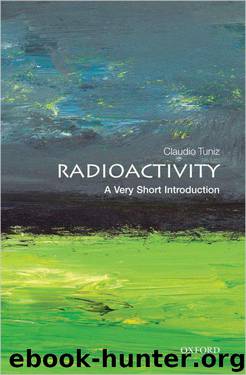Radioactivity: A Very Short Introduction (Very Short Introductions) by Tuniz Claudio

Author:Tuniz, Claudio [Tuniz, Claudio]
Language: eng
Format: epub, mobi
Publisher: Oxford University Press
Published: 2012-07-25T21:00:00+00:00
Dating cells
Atmospheric nuclear weapons tests in the 1950s and 1960s injected a large amount of radiocarbon into the environment. During 1963–4, carbon-14 concentrations reached a level in the northern hemisphere that was 100% higher than that of the pre-nuclear era. After the signature of the Nuclear Test Ban Treaty in 1963, the concentration of radiocarbon has been decreasing with a half-life of 15 years, due to the exchange of carbon with the biosphere and the oceans. In a few years, environmental radiocarbon will return to pre-nuclear era levels. The features of this ‘bomb-pulse’ have been determined by reading the record of carbon-14 in the atmosphere, tree rings, sediments, and ice cores. This effect is somewhat reduced in the southern hemisphere.
Scientists use the radiocarbon bomb pulse to measure cell turnover rates on the timescale of years and decades in organisms that have lived after the 1950s. The chromosomes in cells incorporate carbon-14 from the environment, and the concentration of carbon-14 in a living cell corresponds to the level of carbon-14 in the atmosphere at the time it formed. The genomic DNA, which remains stable after the last mitosis, is used for AMS radiocarbon analysis.
The dating of brain cells through the carbon-14 bomb spike has shown that neurons are not generated after birth in the human cerebral neocortex, where language and intelligence is located. This conclusion is valid within the detection limits of the method, which is based on the analysis of the DNA extracted from 15 million cells, necessary to obtain 30 micrograms carbon for the AMS measurement at better than 1% precision. The method has the potential to map cell renewal for the whole human body and answer questions about the response of critical organs to ageing.
Download
Radioactivity: A Very Short Introduction (Very Short Introductions) by Tuniz Claudio.mobi
This site does not store any files on its server. We only index and link to content provided by other sites. Please contact the content providers to delete copyright contents if any and email us, we'll remove relevant links or contents immediately.
The Complete Stick Figure Physics Tutorials by Allen Sarah(7253)
Secrets of Antigravity Propulsion: Tesla, UFOs, and Classified Aerospace Technology by Ph.D. Paul A. Laviolette(5229)
Thing Explainer by Randall Munroe(3838)
The River of Consciousness by Oliver Sacks(3488)
The Order of Time by Carlo Rovelli(3088)
How To by Randall Munroe(2956)
A Brief History of Time by Stephen Hawking(2902)
I Live in the Future & Here's How It Works by Nick Bilton(2892)
The Great Unknown by Marcus du Sautoy(2605)
What If?: Serious Scientific Answers to Absurd Hypothetical Questions by Randall Munroe(2576)
Midnight in Chernobyl by Adam Higginbotham(2424)
Blockchain: Ultimate Step By Step Guide To Understanding Blockchain Technology, Bitcoin Creation, and the future of Money (Novice to Expert) by Keizer Söze(2402)
Networks: An Introduction by Newman Mark(2293)
The Meaning of it All by Richard Feynman(2259)
Easy Electronics by Charles Platt(2242)
The Tao of Physics by Fritjof Capra(2196)
Midnight in Chernobyl: The Untold Story of the World's Greatest Nuclear Disaster by Adam Higginbotham(2119)
When by Daniel H Pink(2050)
Introducing Relativity by Bruce Bassett(2040)
